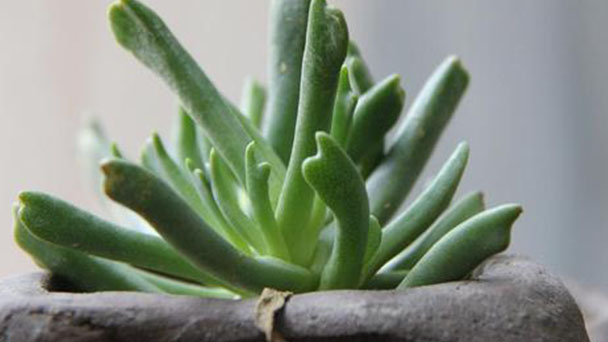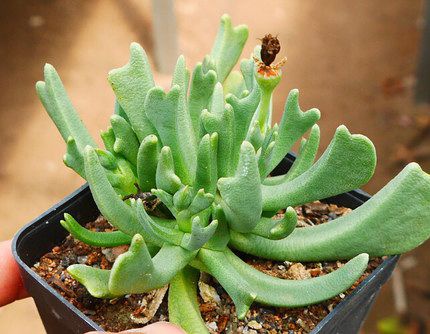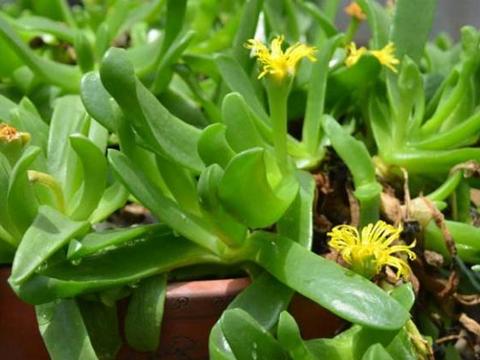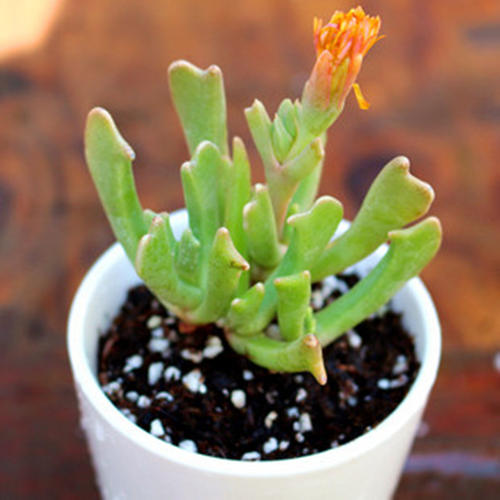Rhombophyllum nelii profile
Written by Maggie
Feb 05 2021

Rhombophyllum nelii is a plant of the genus Rhombophyllum nelii. Rhombophyllum nelii is native to the limestone zone of the Great Karoo Plateau in Cape Province, South Africa. Rhombophyllum nelii prefers sunny and warm, dry conditions. The leaf shape and color are beautiful and have certain ornamental values. Potted plants can be placed in the TV, computer, can also be planted in the room to absorb formaldehyde and other substances, purify the air, quite interesting.
Rhombophyllum nelii picture

Morphological characteristics of Rhombophyllum nelii
Rhombophyllum nelii is a succulent plant, the plant is fleshy shank shape, 20~30 cm high, the stem has a short node, multi - technique. Leaves of rhombophyllum nelii are concentrated at the apex of the branches, opposite, slender and laterally flat, about 1.5 cm long, apex two lobed, the outer arc, like a knife, pale green to grayish green. The flowers are yellow, about 4 cm in diameter.
Distribution range of Rhombophyllum nelii
Rhombophyllum nelii is originally produced in Cape Province, South Africa, now the world can be cultivated in many places.
Rhombophyllum nelii growing method
The temperature
Rhombophyllum nelii likes full sunshine and warm, dry environment, avoiding hot and humid, summer high temperature dormant. Summer high temperature should pay attention to the appropriate shade, avoid exposure.The optimum temperature for Rhombophyllum nelii growth is 15-25 degrees, not less than 10 degrees in winter.
Soil
Rhombophyllum nelii should be planted in a basin soil of medium fertility, good drainage and ventilation of sandy soil, with an appropriate amount of calcareous is best.
Watering
Breeding season of Rhombophyllum nelii, cuttings should not be immediately watered, can air 1-2 days. After watering should not be much, it is OK to keep the basin soil slightly damp. Domestic summer is generally high temperature, then Rhombophyllum nelii in the dormant period, to control watering, strengthen ventilation, to prevent plant decay. Winter can be properly watered to maintain the growth of Rhombophyllum nelii, but to basically maintain the pot soil in a semi-dry state.
Light
Rhombophyllum nelii requires full sun exposure for a compact and beautiful plant form. Too little sunshine leaves green, loosely arranged, elongated. Summer attention to prevent exposure, winter can be kept in the sun room. Spring and autumn can be treated with full sunshine.

Rhombophyllum nelii propagation method
Sowing, decapitation, side - bud cuttage, cross-pollination.
Sowing propagation
The basin soil for sowing propagation of Rhombophyllum nelii should choose the sandy soil with medium fertility, and the soil should be slightly moist and water should be put an end to.
Beheading propagation
The Rhombophyllum nelii propagation method of beheading, flower friends are less used, but want the old plant to grow into "cut the tangle" like vigorous flower friends can try next. After beheading, pay attention to when watering, do not go to the old plant heart watering, prevent decay. Rhombophyllum nelii's group of old plants is very beautiful, of course, do not neglect to cut down to plant new plants!
Lateral bud cuttings
Cut the end of the tender head cuttage, can not only make the old plant type close, new strains of Rhombophyllum nelii resistant and strong!
Cross-pollination
Rhombophyllum nelii's pistils and stamens are not on the same plant, so there is no way to self-pollinate. So those who want their flowers to produce seeds and propagation can use cross-pollination.
The main value of Rhombophyllum nelii
Rhombophyllum nelii has a peculiar leaf shape and is one of the representative varieties of succulents, which can be collected and cultivated by enthusiasts. Because its flower is bright and bright, the general family also can use potted plants of small craft, adorn the place such as a few cases, windowsill, quite appealing.

Latest Updated
- Benefits of Bugleweed - 7 Science-backed Health Benefits
- Bugleweed Dangers & Side Effects - Is It Poisonous?
- How to Plant Evergreen Trees - What You Should Know
- When to Plant Evergreens - Grow Guide for Evergreen Trees
- 12 Wonderful Evergreen Shrubs for Your Garden
- 12 Popular Evergreen Plants with Pictures for Beginners
- When And How To Prune A Lilac Bush Like a Pro
- How to Grow & Care for Lilac Vine (Hardenbergia Violacea)
- Japanese Lilac Tree (Syringa Reticulata) Care & Propagation Guide
- Shumard Oak Pros and Cons - What to Know
Popular Articles
- Winter maintenance of Antirrhinum Majus
- How to Grow Terminalia Mantaly Tree
- How to Grow and Care for Crossostephium Chinense
- How to grow Antirrhinum Majus in spring
- Peristeria Elata (Dove Orchid) Profile: Info & Care Guide
- Underwatered Snake Plant (Sansevieria Trifasciata) - Signs And How To Fix
- How to Care for Brazilian Jasmine Plant (Mandevilla Sanderi)
- How to Grow & Care for Graptopetalum Purple Delight in Summer
- Rosa Chinensis (China Rose): Plant Growing & Care Tips
- How to Care for Baby Sun Rose (Aptenia Cordifolia)